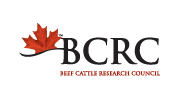Strategies to enhance the use of wheat grain in feedlot diets
| Project Code: | FDE.09.17 |
| Completed: | In Progress. Results expected in March 2023. |
Project Title:
Further strategies to enhance the use of wheat grain in feedlot diets.
Researchers:
Tim McAllister, Ph.D. and Pierre Hucl Ph.D. tim.mcallister@agr.gc.ca
Tim McAllister, Ph.D. (Agriculture Agri-Food Canada Lethbridge), Pierre Hucl Ph.D. (University of Saskatchewan); Harpinder Randhawa Ph.D., Karen Beauchemin Ph.D., Karen Schwartzkopf-Genswein Ph.D., Wenzhu Yang Ph.D., Robert Gruninger Ph.D. (Agriculture Agri-Food Canada Lethbridge); Leluo Guan Ph.D. (University of Alberta); Greg Penner Ph.D., John McKinnon Ph.D. (University of Saskatchewan); Darryl Gibb Ph.D. (Gowans Feed Consulting) Gabriel Ribeiro Ph.D. (University of Calgary)
Background:
Diets with a high concentration of wheat are thought to pose a higher risk of acidosis, founder and liver abscesses than barley-based finishing diets. Wheat can be fed safely if it’s processed like barley, but its kernel variability makes it harder to process properly. Although most cattle feeders prefer to feed barley, Canada’s barley acreage is decreasing and wheat is often cheaper than barley.
Like barley, wheat is susceptible to Fusarium head blight (FHB) or scab, which can produce a mycotoxin called deoxynivalenol (DON), particularly in pink tombstone kernels. FHB also produces fumonisins, trichothecenes (T-2), and zearalenone. Soft wheat generally has higher DON levels than hard wheat. Ruminants are believed to be less susceptible to vomitoxin than monogastrics, but mycotoxin impacts on rumen microbes and feed efficiency of beef cattle really haven’t been studied very closely.
Objectives:To define the impact of processing methods including dry-rolling, tempering and possibly steam flaking on the feed value of wheat. Researchers will also design diets and make recommendations that capture the feed value of wheat without encountering the negative health consequences of clinical and subclinical acidosis and assess if there is any detrimental impact of high levels of doxynivalenol (DON) in wheat fed to feedlot cattle.
What They Will Do:
20 wheat lines (hard and soft, high and low protein, high and low starch, high and low test weight) will be selected from Agriculture Agri-Food Canada and the Crop Development Centre.They will be dry- vs. temper-rolled and used in artificial rumen and cannulated cattle experiments to look for differences in the rate and extent of dry matter and starch breakdown, and to determine whether variety or processing method influences optimal starch utilization or the risk of subclinical or acute acidosis.
High and low protein wheats will be dry- and temper-rolled and fed to 160 steers in an 84d backgrounding (35% wheat grain) and 120d finishing (85% wheat) trial. Cattle will be fed once daily; feed intake and behavior, rumen pH and samples, VFA, NH3-N, protozoa, lipopolysaccharide (an indicator of rumen microbe death), microbial communities, blood serum, hair cortisol, fecal samples (digestibility), hot carcass weight, dressing percentage, backfat, REA, yield, quality grade, and liver scores will be recorded. Liver and rumen epithelium samples will be collected to study gene expression.
DON-free and high DON wheat will be procured and used to formulate diets containing 0, 5, 10 and 20 ppm DON. These will be fed in a finishing diet (85% wheat). The feeding trial and data collection will otherwise be similar to the one described above. Signs of toxicity (anorexia, diarrhea, ataxia) will also be recorded, and livers will be inspected for tumors, cirrhosis, hyperplasia, and the shape and structure of rumen and intestinal cells in cannulated cattle will be inspected.
Implications:
This project will develop refined recommendations for incorporating wheat into feedlot diets. It will provide cattle feeders with additional feed grain options to improve the economics of cattle feeding while maintaining animal health, welfare, performance and carcass quality.








